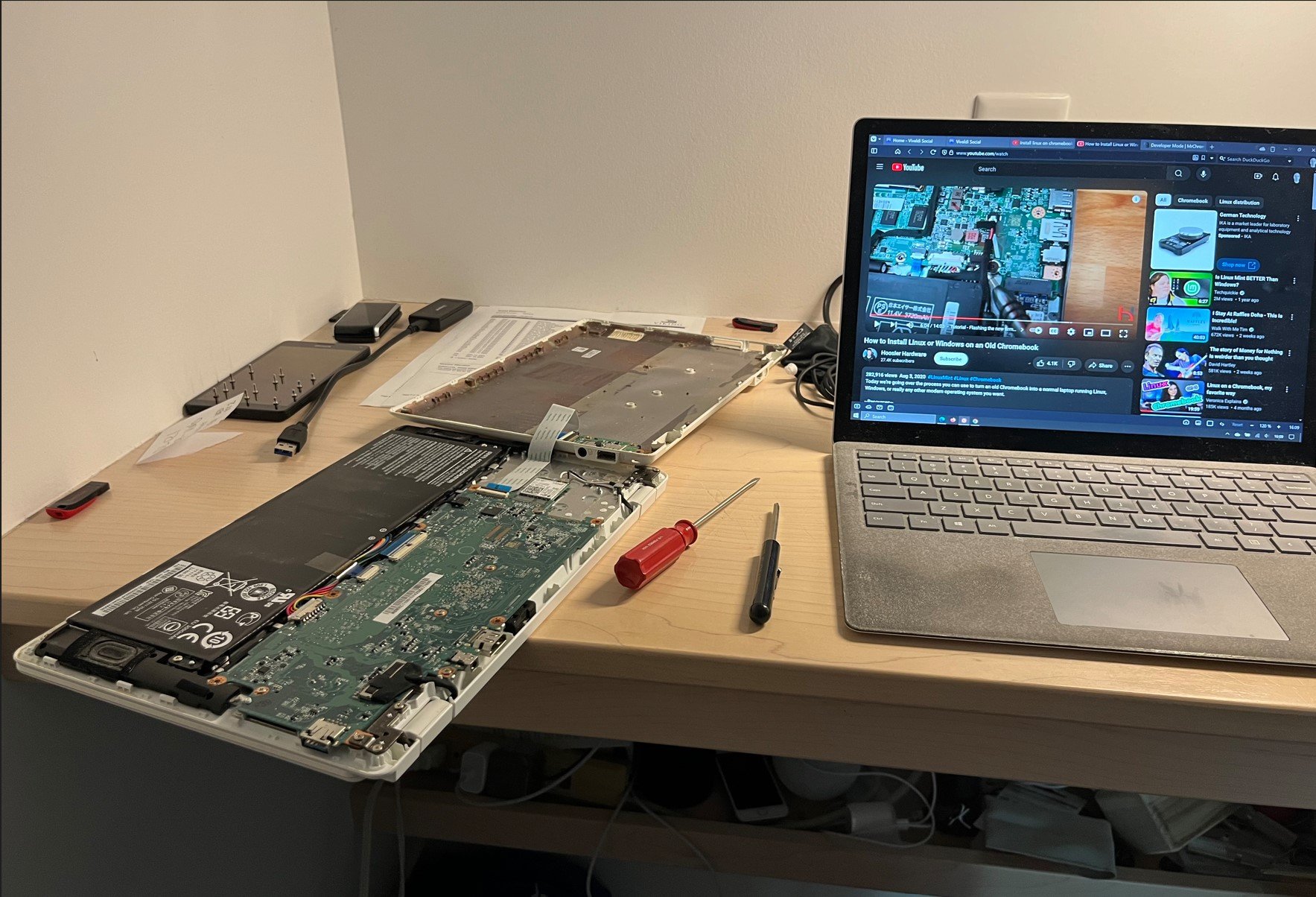Hello! This is my first blog post here, so forgive the rough edges. I hope to edit this to polish it a bit, but wanted to get this down.
I bought a Chromebook back in 2014, and was pretty happy with it. I do pretty much everything online, so I didn’t need a lot of processing power or local storage. I would have loved to use it forever, but Google decided it was too old and would no longer support it, meaning no more security updates.
I was torn. I certainly didn’t want to send a perfectly good machine to the landfill, but without security, I couldn’t use it online with any degree of comfort.
So I turned it into a Linux laptop.
Back in ancient history, I jumped right into the cloud-based life by using an HP Netbook as my primary machine. It ran Ubuntu, and I did everything online. It was a basic Chromebook before Chromebooks existed.
It had been a long time since I’ve run a Linux machine, so I started by test-driving a few Linux distros. One great thing about Linux is you can run it from a USB drive on your computer so you can get a feel for it before actually installing it to your hard drive. Among the OSs I tried were Xubuntu, Ubuntu, Zorin, Mint, Tails.net and Ultramarine (both the flagship and KDE/Plasma versions).
I decided I liked Ultramarine, despite never having heard of them before.
Installing it was a bit of a pain for someone who hadn’t had much experience customizing or hacking a Chromebook. I had to put it into developer mode, then download a bios using the shell.
It mostly worked great, with the exception of having to hit CTRL+L every time I booted to bypass Google’s OS verification warning.
Then one day I hit the spacebar by mistake, turning OS verification back on. After that I had a borked machine that only gave me the error that ChromeOS was not present or was corrupted. 🙁
I was a bit discouraged, and couldn’t get past that to reinstall Linux. What I ended up doing was installing Chrome browser on a Windows machine, and yes, I felt a little slimed, then used the recovery extension to create a USB recovery drive. Then I used that to recover that Chromebook, reinstalling ChromeOS on it.
After that, it was back to Youtube, where I stumbled on a video (link later) that mentioned a Write-Protect Screw. I followed that and opened up the Chromebook to find a screw there was completed a circuit on the motherboard, and as long as that screw was there, it prevented flashing the bios, so it kept it tied to ChromeOS. After removing that screw, it was just a matter of flashing the bios and reinstalling UltraMarine Linux.

Now it’s running Ultramarine Linux KDE/Plasma edition and I’ve removed Firefox and installed Vivaldi, of course and I love it. I’m especially tickled by the Xperience Theme that makes it look like an old-school XP box.
I really wish someone would start a program to collect all these old, unsupported Chromebooks and get school children to reprogram them into usable Linux laptops that they could then take home to use and learn computer basics. Maybe someday I’ll take that on.
Find me on Mastodon or alternatively 500.social
Nice story, well done. I’m shortly going to try Zorin OS (and/or Mint 22) on my perfectly working Lenovo that I can’t upgrade to W11 because Microsoft in their infinite wisdom have decreed the machine is technically incompetent so will no longer support it…. Never had any exposure to any Linux distro in my life before so a tad nervous…..but I’m sure it will be ok (says he, with all fingers, toes and eyes crossed, just in case….).
I agree! I’d maddening that Microsoft (and Google) think it’s okay to force users to trash perfectly usable hardware. I totally understand being nervous about jumping into Linux. What helped for me was to test drive the distro via the live USB thumb drive before actually installing it on the machine. And of course, you’ll want to back up any photos or files before you wipe the machine.
Best of luck to you taking the Linux plunge!
That’s what I’m planning to do…..quite looking forward to it, actually!
“ I really wish someone would start a program to collect all these old, unsupported Chromebooks and get school children to reprogram them into usable Linux laptops that they could then take home to use and learn computer basics.”
Well said and I agree totally. We have to get out of this “Disposable” habit.
When I lived in another city I used to help a chap collect computers and laptops to refurbish. He would collect enough to fill a container and ship them, at his own expense, to his native country in South America where they could be donated to schools and libraries.
Eu sou professor e tem um monte de máquina velha na escola que pode voltar a vida com Linux!
That sounds like a GREAT idea!
I apologize for not responding sooner. I’ve been away out of the country with no internet. It was paradise! 🙂